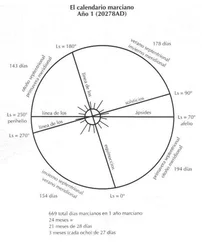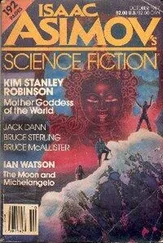“Terran Origins Possible in the Ceraunius Basement Samples.” Vol. 57, 1 January m62. By Claparede, R., and Borazjani, H. X. et al., Department of Ecology, University of Mars, Burroughs.
We examined the nanobacteria-like structures discovered in drill samples on the north flank of Ceraunius Tholus (cf. Forbes and Taneev, m61a). They exhibit the carbonates, magnetites, and PAHs seen in ALH 84001, but no movement or metabolic action. As in the case of ALH 84001 in Antarctica, recent contamination of the rock is a possibility, in this case anthropogenic contamination; hydration of the fault in question may have occurred when the lava tunnel on Ceraunius Tholus was used as a streambed, from m15 to m38. Also, while the samples do contain magnetites, we question whether any indigenous archaea or nanobacteria would evolve to produce magnetites when Mars has a magnetic field so slight that it could not be registered for biological use.
“Ancient Areomagnetosphere Substantially Stronger in the Noachian Epoch Than at Present.” Vol. 57, 2 April m62. By Kim, C. H., Institute of Areophysics, Senzeni Na; and Forbes, G. N., Department of Microbiology, Acheron Institute for Areological Studies.
Paleomagnetic studies in the southern half of the crustal dichotomy demonstrate that the paleointensity of the Martian magnetic field was as high as 250 to 1000 nT as recently as 1.3 Gyr ago, probably because of the presence of an active dynamo in the core. This suggests that Mars generated a magnetic moment greater than 10 13T-m 3(compared with Earth’s moment of 8 × 10 15T-m 3) throughout the Noachian, from approximately 4.1 Gyr to 1.3 Gyr (cf. Russell et al., m6j). Development of biomagnetism in any early indigenous life would therefore be unsurprising.
“Paleomagnetosphere Not Yet Determined.” Vol. 57, 2 August m62. By Russell, S., Da Vinci Co-op Laboratories.
A survey of recent studies indicates the Martian magnetosphere was probably negligible after approximately 3.5 Gyr.
“Similarities between Indigenous Archaea Found under Ceraunius Tholus and the Columbia Basement Archaea Methanospirillum jacobii .” Vol. 58, 1 August m63. By Forbes, G. N., Department of Microbiology, University of Mars, Cairo; Taneev, V. L., Acheron Institute for Areological Studies; and Allan, P. F., Department of Microbiology, University of Mars, Cairo.
The archaealike organisms found in Ceraunius, and what appear to be nanofossils of these organisms, resemble in many physical and chemical respects the Methanospirillum jacobii found in the Columbia River basement rock (see Figure 1.2). Nitrogen in the Martian samples all exhibit the isotropically heavy nitrogen that distinguishes the atmosphere of Mars from virtually all other volatile reservoirs in the solar system, which eliminates contamination as a possible origin. Partial genomic analysis of RNA fragments in the Ceraunius organisms shows a 44.6% match with DNA from the Columbia basement archaea Methanospirillum jacobii . Such a match cannot be explained by independent origin. Seeding of life from one planet to the other is suggested as the most plausible explanation. Lewontin-Thierry mutation-rate analysis gives a tentative date for division of the two species at approximately 3.9 Gyr, near the end of the heavy bombardment.
’Preponderance of Left-Handedness Found in Ceraunius Archaeac Organisms’ Amino Acids.” Vol. 58, 2 October m63. By Forbes, G. N., Allan, P. F., and Wang, W. W., Department of Microbiology, University of Mars, Cairo; and Taneev, V. L., Acheron Institute for Areological Studies.
Left-handedness in amino acids found in Archaea ceraunii from Ceraunius Tholus is shown to predominate in proportion similar to the handedness of the Columbia basement Methanospirillum jacobii (cf. Ellsworth, N. W., 2067a). Organisms dead longer than 1 Myr would have yielded roughly the same amount of left- and right-handed amino acids in the sample, so the high incidence in the Ceraunius samples indicates some specimens must either still be alive, or have been alive in the last Myr. It is now well established (cf. Nabdullah, 2054) that extremophiles under worsening conditions react to the stress by slowing metabolisms to rates in which cell divisions occur less than once a century. With biologic functions temporarily suspended or greatly slowed, indications of life are clearest in biochemical states such as handedness.
“Genomic Analysis of Ceraunius and Columbia Nanobacteria Reveal Recent Division of Populations.” Vol. 59, 1 February m64. By Claparede, R. and Borazjani, H. X., Department of Ecology; and Olson, G. B., and Thresh, J. J. et al., Department of Microbiology, University of Mars, Burroughs.
We determined that, while there appear to be nanobacteria under the north flank of Ceraunius, genomic analysis of DNA fragments from both populations reveals they share 85.4% of their DNA. Mutation rates as recalibrated by Nguyen and McGonklin gave results indicating the two organisms underwent species division within the last 5000 generations. This suggests the rocks of Ceraunius Tholus were contaminated with Terran nanobacteria some 20 m-years ago, which is within the period when the lava tunnel on the north flank of the volcano was used as a streambed. This practice was discontinued by order of the global environmental court (cf. GEC Proceedings , m46, pp.3245–47) because the floor of the tunnel was found to be too porous, and in the words of the report, “risk of contaminating the deep regolith is considerable.”
“Stromatolitic Formations under Ceraunius Tholus Match Structure and Chemical Composition of Hydatogenic Geyserite Discovered under Tharsis Tholus.” Vol. 60, 1 May m65. By Borazjani, H. X., Department of Ecology; Robertson, L. D., Wulf, V. W., and Flores, N., Department of Areology, University of Mars, Burroughs.
A siliceous deposit composed of nearly pure opaline silica was discovered during drilling in Tharsis Tholus. The thermal spring on the west flank, 4.2 kms below the surface, was still active, and the resulting geyserite formation was clearly abiologic in origin. No microbacteria, nanobacteria, archaea, or nanofossils were found in any retrieved rock, all of which was retrieved and handled using GEC-mandated sterilization techniques.
“Mitochondrial Analysis of Archaea ceraunii and Columbia Methanospirillum jacobii Indicate the Ceraunius Population Is the Older of the Two.” Vol. 60, 2 May m65. By Forbes, G. N., Department of Microbiology, and Pieron, I. I., Department of Genetics, University of Mars, Cairo; and Kim, C. H., Institute of Areophysics, Senzeni Na.
Though abiologic processes account for geyserite formations in Ceraunius Tholus, imbibition rates for basaltic lava as calculated by Russell et al., m12t, indicate that the archaea coating the fractures in the basalt cannot have penetrated quickly enough into the rock to be anthropogenic in origin. Mitochondrial analysis clearly shows that the fossil Archaea ceraunii found on site along with living specimens are older than any dated Columbia basement Methanospirillum . Mitochondrial analysis also suggests that the descendant Terran species split from its ancestor about 180 Myr, the time when SNC Crater was formed, and the SNC meteorites thereby cast into space (cf. Matheson, N., 1997b). This indicates that the Terran archaea may have arrived on Earth in the SNC meteorites.
“SNC Crater Not Necessarily the Source of SNC Meteorites.” Vol. 60, 1 December m65. By Claparede, R., Department of Ecology; Xthosa, N., Institute of Areophysics, Senzeni Na; and Taneev, V. L., Acheron Institute for Areological Studies.
Читать дальше
Конец ознакомительного отрывка
Купить книгу












